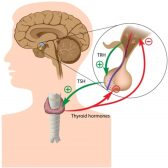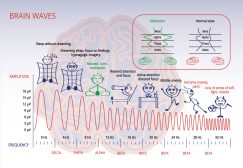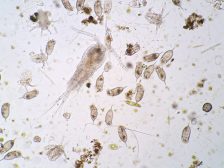Table of Contents
Definition
noun
plural: thymidine diphosphates
(biochemistry) A nucleotide composed of thymine, deoxyribose and two phosphate units, with a chemical formula: C10H16N2O11P2
Details
Overview
A nucleotide is an organic compound made up of three subunits: a nucleobase, a five-carbon sugar, and a phosphate group. The sugar component may either be ribose or deoxyribose. The ribose is the sugar component of the nucleotides that make up RNA. The deoxyribose is the sugar component of DNA. Nucleotides are the monomeric units of nucleic acids. Each phosphate group connects the sugar rings of two adjacent nucleotide monomers. The phosphate groups and the sugar moieties form the backbone of a nucleic acid. The directionality of the chain runs from 5′-end to 3′-end. In DNA, the orientation of the two strands is in opposite directions. This is to allow complementary base pairing between nucleobase constituents. A nucleotide is, thus, a nucleoside with a phosphate group. Depending on the number of phosphate groups attached to the sugar moiety. It may be called nucleoside monophosphate (if with only one phosphate group), nucleoside diphosphate (with two phosphate groups), or nucleoside triphosphate (when with three phosphate groups). Depending on the pentose sugar component, a nucleoside may be a ribonucleoside or a deoxyribonucleoside. A ribonucleoside is a nucleoside with a ribose sugar component. (Depending on the nucleobase component, the ribonucleoside may be adenosine, guanosine, cytidine, uridine, or 5-methyluridine). A deoxyribonucleoside is a nucleoside with a deoxyribose sugar. Depending on the nucleobase component, a deoxyribonucleoside may be deoxyadenosine, deoxyguanosine, deoxycytidine, thymidine, or deoxyuridine. Also, depending on the nucleobase component, the nucleosides may be grouped into either the “double-ringed” purine or the “single-ringed” pyrimidine.
Deoxythymidine diphosphate is a pyrimidine nucleotide composed of thymine, deoxyribose and two phosphate units, with a chemical formula: C10H16N2O11P2
Characteristics
Deoxythymidine diphosphate (dTDP) is a nucleoside phosphate in being comprised of a deoxyribonucleoside and two phosphate units. This means that it has a deoxyribose as its sugar constituent with two phosphate units attached. Its nucleoside contains a pyrimidine base, i.e. a thymine attached to the deoxyribose sugar.
Unlike the other fundamental nucleotides, dTDP is often referred to as thymidine diphosphate (abbreviated as TDP) and the prefix deoxy– is dropped since it is a nucleotide component of DNA and not of RNA. RNA does not have thymine but instead is replaced by another pyrimdine, uracil. DNA, in turn, does not have uracil. Rather, it has thymine in place of the uracil. Thus, the term deoxy– is often dropped since dTDP is implicitly comprised of a deoxyribose sugar. Nevertheless, the abbreviated form dTDP is more widely used than TDP. Both thymine and uracil complementary pairs with adenine.
Uracil is similar to thymine in terms of structure except for the methyl group at position 5 in the heterocyclic aromatic ring present in thymine. One of the possible explanations why DNA has thymine instead of uracil is associated with the conversion of cytosine into uracil by spontaneous deamination. Cytosine can turn into uracil when it loses its amine group. This deamination of cytosine is a common occurrence. Nevertheless, the error is corrected through an inherent DNA repair systems. If not repaired though, it could lead to a point mutation. Had uracil been present in the DNA, the repair systems might not be able to distinguish the original uracil from the cytosine-turned-uracil and therefore may fail to discern which uracil to correct. The presence of methyl group in thymine (which is absent in uracil) helps avert this from happening, thereby, preserving the integrity and stability of the genetic code.
Common biological reactions
Common biological reactions
Thymine, similar to other pyrimidines, is formed from a series of steps, beginning with the formation of carbamoyl phosphate. Carbamoyl phosphate forms from a reaction involving bicarbonate, glutamine, ATP, and water molecule. This process is catalyzed by the enzyme carbamoyl phosphate synthetase. The carbamoyl phosphate is then converted into carbamoyl aspartate through the catalytic activity of aspartate transcarbamylase. Carbamoyl aspartate is next converted into dihydroorotate, which is then oxidized to produce orotate. 5-phospho-α-D-ribosyl 1-pyrophosphate (PRPP), a ribose phosphate, reacts to orotate to form orotidine-5-monophosphate (OMP). OMP is decarboxylated by the enzyme OMP decarboxylase to yield uridine monophosphate (UMP). Eventually, uridine diphosphate (UDP) and uridine triphosphate (UTP) are produced down the biosynthetic pathway by kinases and dephosphorylation of ATPs. In order to synthesize thymidine, uridine is reduced first to deoxyuridine (by the enzyme ribonucleotide reductase). After which, it is methylated by the enzyme thymidylate synthase to form thymidine.
Biological functions
dTDP is a metabolite. It has a role in pyrimidine metabolism.
Supplementary
Abbreviation(s)
- dTDP
- deoxy-TDP
IUPAC name
5-(5-methyl-2,4-dioxopyrimidin-
1-yl)oxolan-2-ylmethyl phosphono hydrogen phosphate
Chemical formula
- C10H16N2O11P2
Synonyms
Further reading
See also
- nucleotide
- DNA
- thymidine
- thymidine monophosphate (dDMP)
- thymidine triphosphate (dDTP)
© Biology Online. Content provided and moderated by Biology Online Editors







